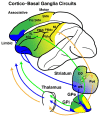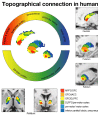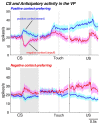Roles of Multiple Globus Pallidus Territories of Monkeys and Humans in Motivation, Cognition and Action: An Anatomical, Physiological and Pathophysiological Review
- PMID: 28442999
- PMCID: PMC5385466
- DOI: 10.3389/fnana.2017.00030
Roles of Multiple Globus Pallidus Territories of Monkeys and Humans in Motivation, Cognition and Action: An Anatomical, Physiological and Pathophysiological Review
Abstract
The globus pallidus (GP) communicates with widespread cortical areas that support various functions, including motivation, cognition and action. Anatomical tract-tracing studies revealed that the anteroventral GP communicates with the medial prefrontal and orbitofrontal cortices, which are involved in motivational control; the anterodorsal GP communicates with the lateral prefrontal cortex, which is involved in cognitive control; and the posterior GP communicates with the frontal motor cortex, which is involved in action control. This organization suggests that distinct subdivisions within the GP play specific roles. Neurophysiological studies examining GP neurons in monkeys during behavior revealed that the types of information coding performed within these subdivisions differ greatly. The anteroventral GP is characterized by activities related to motivation, such as reward seeking and aversive avoidance; the anterodorsal GP is characterized by activity that reflects cognition, such as goal decision and action selection; and the posterior GP is characterized by activity associated with action preparation and execution. Pathophysiological studies have shown that GABA-related substances or GP lesions result in abnormal activity in the GP, which causes site-specific behavioral and motor symptoms. The present review article discusses the anatomical organization, physiology and pathophysiology of the three major GP territories in nonhuman primates and humans.
Keywords: GABA; cortico-basal ganglia circuit; functional territory; globus pallidus; human; nonhuman primate; rabies virus.
Figures






Similar articles
-
Involvement of the globus pallidus in behavioral goal determination and action specification.J Neurosci. 2013 Aug 21;33(34):13639-53. doi: 10.1523/JNEUROSCI.1620-13.2013. J Neurosci. 2013. PMID: 23966686 Free PMC article.
-
Origins of multisynaptic projections from the basal ganglia to the forelimb region of the ventral premotor cortex in macaque monkeys.Eur J Neurosci. 2016 Jan;43(2):258-69. doi: 10.1111/ejn.13127. Epub 2015 Dec 31. Eur J Neurosci. 2016. PMID: 26547510
-
Functional role of the limbic system and basal ganglia in motivated behaviors.J Neurol. 2000 Sep;247 Suppl 5:V23-32. doi: 10.1007/pl00007780. J Neurol. 2000. PMID: 11081801
-
Integration of cognitive and motivational information in the primate lateral prefrontal cortex.Ann N Y Acad Sci. 2007 May;1104:89-107. doi: 10.1196/annals.1390.010. Epub 2007 Apr 7. Ann N Y Acad Sci. 2007. PMID: 17416923 Review.
-
Striatal tissue transplantation in non-human primates.Prog Brain Res. 2000;127:381-404. doi: 10.1016/s0079-6123(00)27018-0. Prog Brain Res. 2000. PMID: 11142037 Review.
Cited by
-
Cerebral Damage after Carbon Monoxide Poisoning: A Longitudinal Diffusional Kurtosis Imaging Study.AJNR Am J Neuroradiol. 2019 Oct;40(10):1630-1637. doi: 10.3174/ajnr.A6201. Epub 2019 Sep 26. AJNR Am J Neuroradiol. 2019. PMID: 31558500 Free PMC article.
-
Aggregation-induced emission luminogens for image-guided surgery in non-human primates.Nat Commun. 2021 Nov 10;12(1):6485. doi: 10.1038/s41467-021-26417-2. Nat Commun. 2021. PMID: 34759280 Free PMC article.
-
The effect of chronic neuroglycopenia on resting state networks in GLUT1 syndrome across the lifespan.Hum Brain Mapp. 2020 Feb 1;41(2):453-466. doi: 10.1002/hbm.24815. Epub 2019 Nov 11. Hum Brain Mapp. 2020. PMID: 31710770 Free PMC article.
-
Inverse pattern of GABAergic system impairment in the external versus internal globus pallidus in male heroin addicts.Eur Arch Psychiatry Clin Neurosci. 2024 Mar;274(2):445-452. doi: 10.1007/s00406-023-01656-0. Epub 2023 Jul 28. Eur Arch Psychiatry Clin Neurosci. 2024. PMID: 37507486 Free PMC article.
-
Connectivity and Functionality of the Globus Pallidus Externa Under Normal Conditions and Parkinson's Disease.Front Neural Circuits. 2021 Mar 2;15:645287. doi: 10.3389/fncir.2021.645287. eCollection 2021. Front Neural Circuits. 2021. PMID: 33737869 Free PMC article.
References
Publication types
LinkOut - more resources
Full Text Sources
Other Literature Sources

